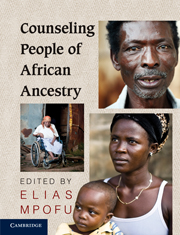Book contents
- Frontmatter
- Contents
- Contributors
- About the Editor
- Editorial Board
- Foreword
- Preface
- Acknowledgments
- PART 1 FOUNDATIONS OF COUNSELING IN AFRICAN SETTINGS
- PART 2 CONTEXTS OF COUNSELING
- 7 School Counseling
- 8 Counseling Students at Tertiary Institutions
- 9 Family Therapy within the African Context
- 10 Pastoral Care and Counseling
- 11 African Refugees: Challenges and Prospects of Resettlement Programs
- 12 Counseling Orphans and Vulnerable Children in Africa
- 13 Diversity Counseling with African Americans
- 14 Resolving Conflict in Africa: In Search of Sustainable Peace
- PART 3 COUNSELING APPLICATIONS
- PART 4 THE FUTURE OF COUNSELING IN AFRICAN HERITAGE SETTINGS
- Counseling People of African Ancestry Multiple Choice Answers
- Index
14 - Resolving Conflict in Africa: In Search of Sustainable Peace
Published online by Cambridge University Press: 05 August 2011
- Frontmatter
- Contents
- Contributors
- About the Editor
- Editorial Board
- Foreword
- Preface
- Acknowledgments
- PART 1 FOUNDATIONS OF COUNSELING IN AFRICAN SETTINGS
- PART 2 CONTEXTS OF COUNSELING
- 7 School Counseling
- 8 Counseling Students at Tertiary Institutions
- 9 Family Therapy within the African Context
- 10 Pastoral Care and Counseling
- 11 African Refugees: Challenges and Prospects of Resettlement Programs
- 12 Counseling Orphans and Vulnerable Children in Africa
- 13 Diversity Counseling with African Americans
- 14 Resolving Conflict in Africa: In Search of Sustainable Peace
- PART 3 COUNSELING APPLICATIONS
- PART 4 THE FUTURE OF COUNSELING IN AFRICAN HERITAGE SETTINGS
- Counseling People of African Ancestry Multiple Choice Answers
- Index
Summary
OVERVIEW. Conflict is a normal part of human life. A person may argue with his or her life partner, parents, or friends. It is inevitable that at some point in time one will be in a conflicting situation with someone. Individuals have different ideas about how to do things and how to access and compete for scarce resources. In Africa social conflict and its resolution is the primary concern of this chapter. The chapter defines social conflict and discusses its associated theoretical paradigms and processes. It provides an assessment of conflict and explores holistic approaches to conflict resolution that go beyond negotiation and mediation. Lastly, the chapter highlights the role of counselors in constructing sustainable peace in Africa.
LEARNING OBJECTIVES
By the end of the chapter, the reader should be able to:
Define social conflict.
Analyze the phenomenon of social conflict according to its various theoretical paradigms.
Provide an assessment of social conflict in Africa (including traditional conflict management processes).
Highlight the role of social psychology in conflict resolution in Africa.
INTRODUCTION
Between 1946 and 2011 there were at least 276 armed conflicts worldwide. Nearly half of them occurred after 1989. No fewer than 116 of those – or just over half – occurred between 1989 and 2002 in seventy-nine different locations around the world. In 2002 alone, there were thirty-one active conflicts in twenty-four locations.
- Type
- Chapter
- Information
- Counseling People of African Ancestry , pp. 209 - 226Publisher: Cambridge University PressPrint publication year: 2011

